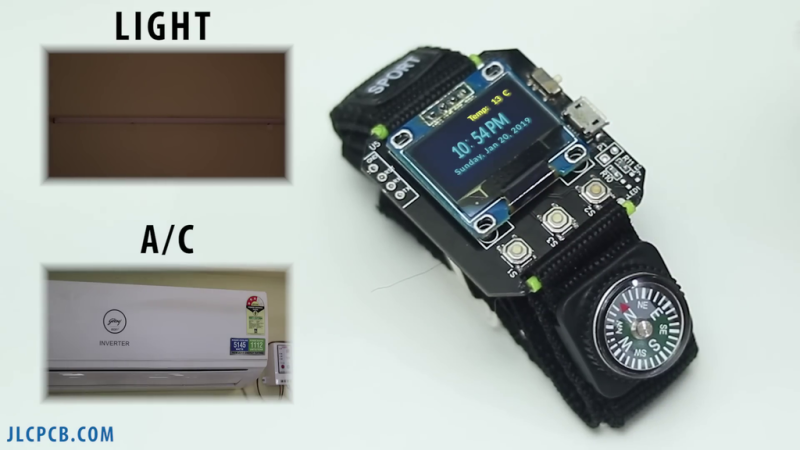These days, we live in a post-Dick Tracy world, where you can make a phone call with your fancy wristwatch, and lots more besides. [akashv44] has gone a simpler route, designing their own from scratch with a bare PCB design.
The build is based around the ESP-12E microcontroller, providing useful wireless connectivity that lets the watch interface with the outside world. The firmware makes queries of NTP servers and Yahoo’s weather API to collect time and weather data for display. It’s also capable of interacting with Blynk relay modules for controlling other equipment, which [akashv44] uses with lights and an air conditioner. The watch uses a small OLED display and a handful of small surface-mount tactile buttons for control. Power is courtesy of a small lithium-ion pouch cell, with charging handled by a TP4056 battery management IC.
It’s a simple smartwatch, but nonetheless one that teaches all kinds of useful skills in embedded development and design. It’s also funny to think how simple it is to build. A decade ago, before the ESP8266 was released, getting wireless connectivity in such a small package was a major engineering challenge. Even the Apple Watch didn’t come out until 2015! Food for thought.















I’d have gone with an esp32 for added Bluetooth and better ability to sleep. If space is an issue use a c3.
It was not a major challenge a decade ago
Buy a TI Chronos for 30 bucks. Job done.
But it was a major challenge to buy a TI Chrronos!
At that point why not just buy a ready-made smartwatch? Feels to me like it would miss the point.
If that is the display I think it is, it will shatter irreparably the first time it comes in to contact with anything without protection.
You’d need to put it in a transparent plastic case. These screens really break instantly
It’s a fun thing to make and I don’t want to be too critical… But it’s actually dangerous.
Of course the battery time will be low and the screen will shatter the first time a butterfly looks at it – that’s fine for a fun project like this – but, I wouldn’t trust one of those battery pouches strapped to my bare wrist with no protection on one side and components squished into it on the other side.
Just imagine what a battery fire FEELS like when it’s literally strapped to your arm. Not to mention the smell. All it takes is one tiny puncture and your year is ruined.
There are more problems with this design:
1. The display will crack on any impact or pressure.
2. Sweat and any accidental exposure to water will cause failure, with potential risk of shorting the battery. This requires conformal coating at least.
3. ESP-8266 is not the best choice for long battery life.
4. Strap holes have narrow walls – one of them will break at any accidental snag or bump.
Just 3D print a case and add polycarbonate/acrylic/glass front. Use something that’s UV-resistant, like ASA.
But then it would not be a hack anymore…
It’s not a hack now. Just a project/prototype. Great start, but needs a bit more developing. Now it’s unsafe to be worn.
All these comments (criticisms) are accurate but I think Lewin said it best:
It’s a simple smartwatch, but nonetheless one that teaches all kinds of useful skills in embedded development and design
I’m not sure how many of the commenters here have actually punctured these tiny little lipos themselves. I have punctured many, and the small size essentially limits their thermal output before they ever even become uncomfortably hot. Sure, some massive quadcopter battery or a full sized cell phone is going to be pretty violent, but these small LiPos, they are fine.
One such battery actually puffed up in my fake bone conducting headphones when I was wearing them. I shorted out another one in different headphones. No explosion, nor fire, yest still it was scary experience.
The word ‘smart’ is reserved for things that allow governments/large corporations to intrusively spy on you.
So don’t use that word for home-made stuff that does not do that. Unless you enter in an agreement to send data to such entities of course.
Are you smart?
:P